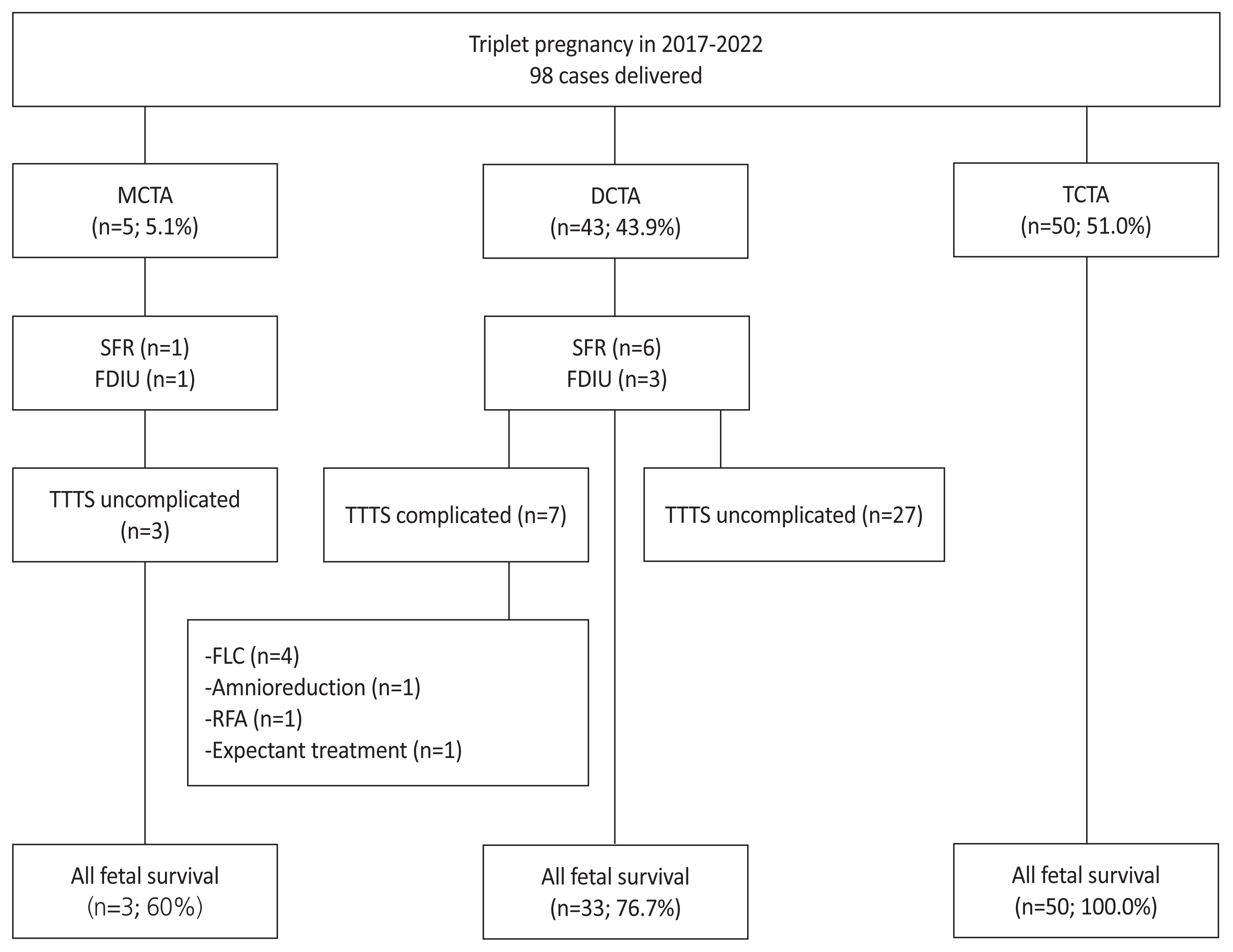Obstet Gynecol Sci.
2023 Sep;66(5):385-394. 10.5468/ogs.23111.
Feasibility of fetoscopic laser coagulation in triplet pregnancy
- Affiliations
-
- 1Department of Obstetrics and Gynecology, University of Ulsan College of Medicine, Asan Medical Center, Seoul, Korea
- KMID: 2545885
- DOI: http://doi.org/10.5468/ogs.23111
Abstract
Objective
To report the experiences of triplet pregnancies complicated by twin-to-twin transfusion syndrome (TTTS) treated with fetoscopic laser coagulation at a single center.
Methods
Herein, we conducted a retrospective analysis to investigate the management and perinatal outcomes of triplet pregnancies with TTTS treated at a single institution between 2017 and 2022.
Results
Seven of the 98 triplet pregnancies (7.1%) encountered were complicated by TTTS, and all were dichorionic triamniotic triplets. Of the seven triplet pregnancies complicated by TTTS, four were treated with fetoscopic laser coagulation at our center, at a median gestational age of 20 weeks. No procedure-related complications or maternal complications were observed. The survival rate was higher and perinatal outcomes were better in fetoscopic laser coagulation cases than in other management cases. Four donor and four recipient triplets survived, with a median gestational age of 33 weeks at delivery. Although there were no cases of poor neonatal outcomes, one case was diagnosed with white matter injury, suspected to be hypoxic-ischemic encephalopathy on postnatal investigation.
Conclusion
Fetoscopic laser coagulation is a feasible treatment option for triplet TTTS, provided the attending specialists have extensive experience with this technique.
Keyword
Figure
Reference
-
References
1. Bamberg C, Hecher K. Update on twin-to-twin transfusion syndrome. Best Pract Res Clin Obstet Gynaecol. 2019; 58:55–65.2. Peeters SH, Middeldorp JM, Lopriore E, Klumper FJ, Oepkes D. Monochorionic triplets complicated by fetofetal transfusion syndrome: a case series and review of the literature. Fetal Diagn Ther. 2012; 32:239–45.3. Quintero RA, Morales WJ, Allen MH, Bornick PW, Johnson PK, Kruger M. Staging of twin-twin transfusion syndrome. J Perinatol. 1999; 19:550–5.4. Hernandez-Andrade E, López-Tenorio J, Figueroa-Diesel H, Sanin-Blair J, Carreras E, Cabero L, et al. A modified myocardial performance (Tei) index based on the use of valve clicks improves reproducibility of fetal left cardiac function assessment. Ultrasound Obstet Gynecol. 2005; 26:227–32.5. Kiserud T, Piaggio G, Carroli G, Widmer M, Carvalho J, Neerup Jensen L, et al. The World Health Organization fetal growth charts: a multinational longitudinal study of ultrasound biometric measurements and estimated fetal weight. PLoS Med. 2017; 14:e1002220.6. Khalil A, Rodgers M, Baschat A, Bhide A, Gratacos E, Hecher K, et al. ISUOG practice guidelines: role of ultrasound in twin pregnancy. Ultrasound Obstet Gynecol. 2016; 47:247–63.7. Kawaguchi H, Ishii K, Yamamoto R, Hayashi S, Mitsuda N; Perinatal Research Network Group in Japan. Perinatal death of triplet pregnancies by chorionicity. Am J Obstet Gynecol. 2013; 209:36e1–7.8. Chasen ST, Al-Kouatly HB, Ballabh P, Skupski DW, Chervenak FA. Outcomes of dichorionic triplet pregnancies. Am J Obstet Gynecol. 2002; 186:765–67.9. Kim R, Lee MY, Won HS, Kim JM, Lee YJ, Jeong BD, et al. Perinatal outcomes and factors affecting the survival rate of fetuses with twin-to-twin transfusion syndrome treated with fetoscopic laser coagulation: a single-center seven-year experience. J Matern Fetal Neonatal Med. 2022; 35:5595–606.10. Mustafa HJ, Javinani A, Krispin E, Tadbiri H, Shamshirsaz AA, Espinoza J, et al. Perinatal outcomes of fetoscopic laser surgery for twin-twin transfusion syndrome in triplet pregnancy: cohort study, systematic review and meta-analysis. Ultrasound Obstet Gynecol. 2022; 60:42–51.11. Senat MV, Deprest J, Boulvain M, Paupe A, Winer N, Ville Y. Endoscopic laser surgery versus serial amnioreduction for severe twin-to-twin transfusion syndrome. N Engl J Med. 2004; 351:136–44.12. Lopriore E, van Wezel-Meijler G, Middeldorp JM, Sueters M, Vandenbussche FP, Walther FJ. Incidence, origin, and character of cerebral injury in twin-to-twin transfusion syndrome treated with fetoscopic laser surgery. Am J Obstet Gynecol. 2006; 194:1215–20.13. Lenclen R, Paupe A, Ciarlo G, Couderc S, Castela F, Ortqvist L, et al. Neonatal outcome in preterm monochorionic twins with twin-to-twin transfusion syndrome after intrauterine treatment with amnioreduction or fetoscopic laser surgery: comparison with dichorionic twins. Am J Obstet Gynecol. 2007; 196:450e1–7.14. Cincotta RB, Gray PH, Gardener G, Soong B, Chan FY. Selective fetoscopic laser ablation in 100 consecutive pregnancies with severe twin-twin transfusion syndrome. Aust N Z J Obstet Gynaecol. 2009; 49:22–7.15. Spruijt M, Steggerda S, Rath M, van Zwet E, Oepkes D, Walther F, et al. Cerebral injury in twin-twin transfusion syndrome treated with fetoscopic laser surgery. Obstet Gynecol. 2012; 120:15–20.16. Stirnemann J, Chalouhi G, Essaoui M, Bahi-Buisson N, Sonigo P, Millischer AE, et al. Fetal brain imaging following laser surgery in twin-to-twin surgery. BJOG. 2018; 125:1186–91.17. Akkermans J, Peeters SH, Middeldorp JM, Klumper FJ, Lopriore E, Ryan G, et al. A worldwide survey of laser surgery for twin-twin transfusion syndrome. Ultrasound Obstet Gynecol. 2015; 45:168–74.18. Van Schoubroeck D, Lewi L, Ryan G, Carreras E, Jani J, Higueras T, et al. Fetoscopic surgery in triplet pregnancies: a multicenter case series. Am J Obstet Gynecol. 2004; 191:1529–32.19. Argoti PS, Papanna R, Bebbington MW, Kahlek N, Baschat A, Johnson A, et al. Outcome of fetoscopic laser ablation for twin-to-twin transfusion syndrome in dichorionic-triamniotic triplets compared with monochorionic-diamniotic twins. Ultrasound Obstet Gynecol. 2014; 44:545–9.
- Full Text Links
- Actions
-
Cited
- CITED
-
- Close
- Share
- Similar articles
-
- Intrafetal Laser Treatment for Selective Feticide in Monochorionic Multiple Pregnancies
- Fetal Survival Immediate after Fetoscopic Laser Ablation in Twin to Twin Transfusion Syndrome
- A Case of Acardiac Fetus in a Triplet Pregnancy
- Complete Hydatidiform Mole Coexisting Two Live Fetuses in Triplet Pregnancy
- Monochorionic Triamniotic Triplet Pregnancy Following Assisted Reproductive Technology and Radiofrequency Ablation for Selective Reduction




